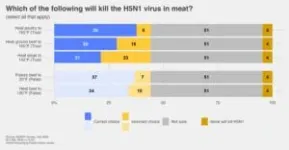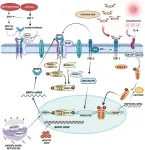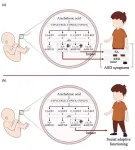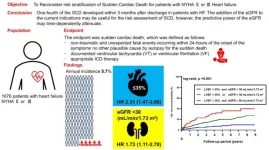(Press-News.org) PHILADELPHIA – With bird flu virus detected in cow’s milk, U.S. health authorities have warned the public against potential sources of exposure, including drinking raw or unpasteurized milk, and have reiterated a general warning that consuming uncooked or undercooked poultry or beef products can make you sick.
Relatively few people say they drink raw milk. Only 3% of U.S. adults report having consumed raw milk in the past 12 months, while 4% were not sure whether they had, according to a new nationally representative Annenberg Public Policy Center health survey of nearly 1,500 empaneled U.S. adults conducted in July.*
But many more people say they do not use a thermometer to ensure that their food is heated to a temperature high enough to kill bacteria and viruses, including avian influenza A viruses like the H5N1 strain now found in U.S. cattle. And most are unsure what internal food temperatures kill bacteria and viruses, according to the survey.
Using a food thermometer
Only about 1 in 4 U.S. adults (27%) report using a thermometer either “often” or “all the time” to check whether the meat, poultry, or fish they consume has reached an internal temperature that makes the food safe to eat. A similar proportion (29%) say they “never” use a thermometer to check food temperatures while 20% say they do “rarely” and 20% “sometimes.”
“Using a food thermometer to determine that meat, poultry, fish, and eggs have been cooked to a safe internal temperature, one that kills bacteria such as E. coli and salmonella, is a way of protecting yourself from food poisoning,” said Kathleen Hall Jamieson, director of the Annenberg Public Policy Center (APPC) of the University of Pennsylvania. “Every cook should have a food thermometer within ready reach in the kitchen or near the grill.”
The data come from the 20th wave of a nationally representative panel of 1,496 U.S. adults, conducted for the Annenberg Public Policy Center by SSRS, an independent market research company. This wave of the Annenberg Science and Public Health (ASAPH) Knowledge survey was fielded July 11-18, 2024, and has a margin of sampling error (MOE) of ± 3.6 percentage points at the 95% confidence level. See the topline and methodology for details.
Most unsure of correct food temperatures to kill viruses such as bird flu
According to the Centers for Disease Control and Prevention (CDC), “While there is no evidence that anyone in the United States has gotten infected with avian influenza A viruses after eating properly handled and cooked poultry products, uncooked poultry and poultry products (like blood) could have been the source of a small number of avian influenza A virus infections in people in Southeast Asia. The USDA reported in May as part of testing of 96 dairy cows that the virus had been detected in the meat of one “cull” cow but it did not enter the food chain and the USDA is confident that the meat supply is safe: “While we have multiple safeguards in place to protect consumers, we continue to recommend consumers properly handle raw meats and cook to a safe internal temperature.”
The APPC survey finds that most U.S. adults do not know the correct temperatures to heat food to in order to kill the H5N1 virus, or bird flu. Thinking about the virus, the survey respondents were asked to indicate which of the measures below “will kill the H5N1 virus,” and to select all that apply. Over half of those surveyed (51%) indicated “not sure” on this item and 4% incorrectly said “none will kill”:
Heating poultry to at least 165 degrees Fahrenheit (CORRECT): Fewer than 4 in 10 (38%) selected this option as correct. According to the CDC, cooking poultry and eggs to an internal temperature of 165 degrees kills bacteria and viruses, including H5N1.
Heating ground beef to at least 165 degrees Fahrenheit (CORRECT): This is true, but less than 1 in 3 people surveyed (29%) selected it. (In fact, the CDC recommends heating ground beef to at least 160 degrees.)
Heating steak to a least 145 degrees (CORRECT): Just over 1 in 5 (21%) selected this as correct. According to the CDC, whole cuts of beef should be heated to 145 degrees then allowed to rest for three minutes.
Freezing beef to a temperature of at least 20 degrees Fahrenheit (INCORRECT): Only 7% chose this thinking it is correct (it is not). Bird flu survives indefinitely while frozen and remains infectious, according to the Occupational Safety and Health Administration.
Heating beef to at least 120 degrees (INCORRECT): Only 10% chose this, but it is not correct.
The bird flu outbreak
Unpasteurized or raw milk comes from animals including cows, sheep, and goats, and it has not been pasteurized to kill harmful germs. Unpasteurized dairy products are estimated to “cause 840 times more illnesses and 45 times more hospitalizations than pasteurized products.” The CDC says that consuming unpasteurized milk and products made from it “can expose people to germs such as Campylobacter, Cryptosporidium, E. coli, Listeria, Brucella, and Salmonella.”
In fact, 171 people were sickened and 22 hospitalized from September 2023 to March 2024 in a salmonella outbreak connected to unpasteurized milk from Raw Farm, in Fresno, Calif., according to the New York Times, which said this is the largest recorded outbreak in over two decades linked to raw milk.
In June, the FDA reported in an open letter that bird flu, or the H5N1 avian influenza virus, has been detected in cow’s milk. The presence of H5N1 bird flu was confirmed in cattle in the United States in mid-March 2024. As of July 25, 2024, there had been 13 human cases of bird flu in the United States since April 2024, four following exposure to cows and nine following exposure to poultry in Colorado. As of mid-July, 168 cattle herds in 13 states – and over 100 million poultry in 48 states – were affected.
Raw milk and bird flu
As of mid-June 2024, the FDA concluded “that the totality of evidence continues to indicate that the commercial milk supply [which is pasteurized] is safe.” The FDA says it does not currently know whether the H5N1 virus can be transmitted to humans through consumption of raw milk products from infected cows, though a study with mice concluded that the virus in “untreated milk can infect susceptible animals that consume it” and the National Institutes of Health (NIH) says this suggests that drinking raw milk “may pose a risk of transmission to people.”
The Annenberg survey finds that 15% of respondents think drinking raw milk increases the chances of getting bird flu, while 33% think it has no effect one way or the other on the chances of getting bird flu. Nearly half of those surveyed (49%) are not sure.
What people know of pasteurization and the risks of raw milk
According to the CDC, pasteurization “is crucial for milk safety, killing harmful germs that can cause illness” and the NIH says “dairy milk purchased in the grocery store has been pasteurized – heated to a level high enough and long enough to kill most viruses or bacteria in the milk.”
Yet the current survey shows just over half of those surveyed (54%) know that unpasteurized milk is less safe to drink than pasteurized milk. While 6% say raw milk is safer to drink and 13% say it is just as safe, 27% say they are not sure which is safer.
The survey also finds that:
Bacteria and viruses: 62% think it is likely that raw milk contains bacteria and viruses that can make you sick, while 16% say it is unlikely and 22% are not sure.
Effectiveness of pasteurization: 77% know pasteurization is effective at killing bacteria and viruses in raw milk, while 4% say it is not effective and 20% are not sure.
Nutrients: Over a quarter of those surveyed (26%) say raw milk has more nutrients than pasteurized milk, 30% think it has “about the same amount of nutrients as pasteurized milk,” and 40% are not sure.
While those who advocate for drinking raw milk contend that pasteurization destroys valuable nutrients, the FDA says that raw milk “is not nutritionally superior” to pasteurized milk.
Bird flu and the seasonal flu vaccine
Nearly two-thirds of those surveyed do not know that the seasonal flu vaccine will not help prevent bird flu – 21% think it does help a person who is exposed to the H5N1 bird flu from developing severe illness and 44% are not sure whether it does. Just over a third of those surveyed (35%) know that the seasonal flu vaccine does not help someone exposed to bird flu from developing severe illness.
APPC’s ASAPH survey
The survey data come from the 20th wave of a nationally representative panel of 1,496 U.S. adults, first empaneled in April 2021, conducted for the Annenberg Public Policy Center by SSRS, an independent market research company. This wave of the Annenberg Science and Public Health Knowledge (ASAPH) survey was fielded July 11-18, 2024, and has a margin of sampling error (MOE) of ± 3.6 percentage points at the 95% confidence level. All figures are rounded to the nearest whole number and may not add to 100%. Combined subcategories may not add to totals in the topline and text due to rounding.
See the topline and methodology for additional details.
The policy center has been tracking the American public’s knowledge, beliefs, and behaviors regarding vaccination, Covid-19, flu, maternal health, climate change, and other consequential health issues through this Annenberg Science and Public Health (ASAPH) survey panel for over three years. In addition to Jamieson, the APPC team includes senior data analyst Laura Gibson; research analyst Shawn Patterson Jr.; Patrick E. Jamieson, director of the Annenberg Health and Risk Communication Institute, who developed the questions; and Ken Winneg, managing director of survey research.
The Annenberg Public Policy Center was established in 1993 to educate the public and policy makers about communication’s role in advancing public understanding of political, science, and health issues at the local, state, and federal levels.
* The percentage of raw milk drinkers found in the APPC survey, which included non-milk drinkers, is roughly consistent with a Food and Drug Administration (FDA) 2016 food safety report finding that 4% of U.S. adults who drink milk reported having had raw milk over the prior 12 months. Unlike the FDA survey, the APPC survey gave people the explicit option of indicating that they were not sure.
END
Despite risk, many unsure of temperature to heat food to prevent illness
Only 1 in 4 Americans often or always use a thermometer when cooking
2024-07-29
ELSE PRESS RELEASES FROM THIS DATE:
YAP/TAZ interactions can confer resistance to anti-tumor drug indisulam
2024-07-29
In a healthy human body, tissue growth and development are coordinated by many different mechanisms. Within our bodies, these mechanisms regulate the healthy growth of cells, limit their size and number, and control the timing of cell death through apoptosis. However, when these regulatory pathways are altered, or break down, cell growth and proliferation may increase beyond what is safe and this can lead to cancer. One critical cell growth regulatory mechanism is the Hippo signaling pathway. This pathway regulates the expression of several genes that control cell proliferation ...
Asbestos-related cancer: exaggerated risk perception
2024-07-29
Asbestos, a group of naturally occurring fibrous minerals, has been historically used for its durability and resistance to heat. Despite its advantageous properties, asbestos is a well-documented carcinogen, linked to diseases such as lung cancer (LC) and malignant pleural mesothelioma (MPM). The controversy surrounding the degree of carcinogenicity of different asbestos types, especially chrysotile versus amphibole asbestos, continues to influence scientific and regulatory discussions. This review delves into the various aspects of asbestos-related research, focusing on historical context, risk assessment, environmental ...
Gropp, former NCSA leaders selected for HPCwire’s inaugural ‘35 Legends’ list
2024-07-29
NCSA Director Bill Gropp and two former Center directors were chosen for the first-ever HPCwire “35 Legends” list in celebration of the publication’s 35th anniversary.
Thirty-five honorees will be announced each year, selected by HPCwire editors and advisors based on their contributions to the high-performance computing community over the past 35 years and celebrated for the different ways they’ve helped move HPC forward.
Gropp, NCSA’s Founding Director Larry Smarr and Former Director Daniel Reed were among the first 17 honorees announced in July. The remaining HPCwire 35 Legends will be ...
The sooner the better: teaching healthy habits in elementary school reduces abdominal fat
2024-07-29
A study led by the Centro Nacional de Investigaciones Cardiovasculares (CNIC) and Fundación SHE, supported by “la Caixa” Foundation, demonstrates that teaching healthy habits through classroom activities helps to prevent the accumulation of abdominal fat during the first school years.
The study, published in the Journal of the American College of Cardiology (JACC), is one of the largest contemporary school-based health promotion studies and has one of the most extensive participant follow-up schedules.
The conclusions are clear: early intervention to promote healthy habits in elementary school children can be more ...
Exploring the impact of iron overload on mitochondrial DNA in β-thalassemia
2024-07-29
β-Thalassemia is a genetic disorder characterized by reduced or absent synthesis of the beta chains of hemoglobin, leading to ineffective erythropoiesis and severe anemia. Patients with transfusion-dependent β-thalassemia (TDT) require regular blood transfusions to maintain adequate hemoglobin levels. Non-transfusion-dependent thalassemia (NTDT) patients manage their anemia without regular transfusions but still experience significant health complications. Iron overload is a common and severe complication in both TDT and NTDT patients ...
Fatty acids in umbilical cord blood might cause autism spectrum disorder
2024-07-29
Autism spectrum disorder (ASD) is a neurodevelopmental disorder that affects learning capability and social behavior of people. Over the past few decades, awareness regarding ASD has increased, especially regarding its prevalence and effect on the lives of people diagnosed with ASD. However, several aspects related to ASD are not well understood, leaving much to be explored.
Although the exact causes of ASD are unclear, currently available evidence points to neuroinflammation as a major factor. Several studies in mouse models of ASD have hinted at the importance of polyunsaturated ...
Kidney dysfunction may predict sudden cardiac death in patients with heart failure
2024-07-29
Patients with congestive heart failure (CHF) having a compromised blood supply, are at greater risk of sudden cardiac death (SCD). With an estimated incidence as high as 22% among these patients, current clinical guidelines recommend using implantable cardioverter defibrillators (ICDs) to help mitigate the risk of SCD.
Although the application of ICDs in patients with CHF is backed by substantial evidence, these studies did not include people with chronic kidney disease (CKD), who are an important clinical population. In other ...
Virus that causes COVID-19 is widespread in wildlife, Virginia Tech scientists find
2024-07-29
SARS-CoV-2, the virus responsible for COVID-19, is widespread among wildlife species, according to Virginia Tech research published Monday (July 29, 2024) in Nature Communications. The virus was detected in six common backyard species, and antibodies indicating prior exposure to the virus were found in five species, with rates of exposure ranging from 40 to 60 percent depending on the species.
Genetic tracking in wild animals confirmed both the presence of SARS-CoV-2 and the existence of unique viral mutations with lineages closely matching variants circulating in humans at the time, further supporting human-to-animal transmission, the study found.
The highest exposure to SARS ...
Study tracks exposure to air pollution through the day
2024-07-29
There are significant differences in how much people are exposed to air pollution, according to a new study co-authored by MIT scholars that takes daily mobility into account.
The study, based in the Bronx, New York, does not just estimate air pollution exposure based on where people live or work, but uses mobile data to examine where people go during a typical day, building a more thorough assessment of the environment’s impact on them.
The research finds exposure to particulate matter 2.5 microns or bigger rises by about 2.4 percent when daily travel patterns are taken into account.
“One of the main strengths of the study is that we ...
UC San Diego researchers use non-invasive technique to record involuntary nervous system
2024-07-29
A research team led by UC San Diego has, for the first time, shown that a wearable, non-invasive device can measure activity in human cervical nerves in clinical settings.
The device records what the team calls Autonomic Neurography (ANG), neural activity from the human vagus and carotid sinus nerves as well as other autonomic nerves found in the skin and muscle of the neck. The vagus nerve is a “superhighway” of the involuntary nervous system, with tendrils extending from the base of the skull through the torso and abdomen to influence digestion, heart rate and the immune system. The vagus nerve ...
LAST 30 PRESS RELEASES:
Why nail-biting, procrastination and other self-sabotaging behaviors are rooted in survival instincts
Regional variations in mechanical properties of porcine leptomeninges
Artificial empathy in therapy and healthcare: advancements in interpersonal interaction technologies
Why some brains switch gears more efficiently than others
UVA’s Jundong Li wins ICDM’S 2025 Tao Li Award for data mining, machine learning
UVA’s low-power, high-performance computer power player Mircea Stan earns National Academy of Inventors fellowship
Not playing by the rules: USU researcher explores filamentous algae dynamics in rivers
Do our body clocks influence our risk of dementia?
Anthropologists offer new evidence of bipedalism in long-debated fossil discovery
Safer receipt paper from wood
Dosage-sensitive genes suggest no whole-genome duplications in ancestral angiosperm
First ancient human herpesvirus genomes document their deep history with humans
Why Some Bacteria Survive Antibiotics and How to Stop Them - New study reveals that bacteria can survive antibiotic treatment through two fundamentally different “shutdown modes”
UCLA study links scar healing to dangerous placenta condition
CHANGE-seq-BE finds off-target changes in the genome from base editors
The Journal of Nuclear Medicine Ahead-of-Print Tip Sheet: January 2, 2026
Delayed or absent first dose of measles, mumps, and rubella vaccination
Trends in US preterm birth rates by household income and race and ethnicity
Study identifies potential biomarker linked to progression and brain inflammation in multiple sclerosis
Many mothers in Norway do not show up for postnatal check-ups
Researchers want to find out why quick clay is so unstable
Superradiant spins show teamwork at the quantum scale
Cleveland Clinic Research links tumor bacteria to immunotherapy resistance in head and neck cancer
First Editorial of 2026: Resisting AI slop
Joint ground- and space-based observations reveal Saturn-mass rogue planet
Inheritable genetic variant offers protection against blood cancer risk and progression
Pigs settled Pacific islands alongside early human voyagers
A Coral reef’s daily pulse reshapes microbes in surrounding waters
EAST Tokamak experiments exceed plasma density limit, offering new approach to fusion ignition
Groundbreaking discovery reveals Africa’s oldest cremation pyre and complex ritual practices
[Press-News.org] Despite risk, many unsure of temperature to heat food to prevent illnessOnly 1 in 4 Americans often or always use a thermometer when cooking








